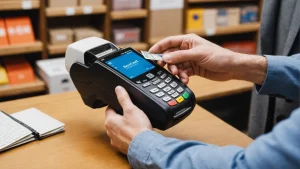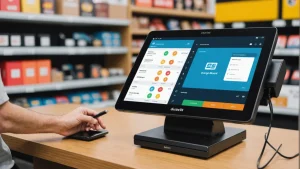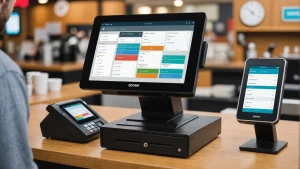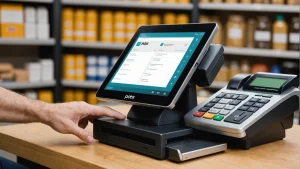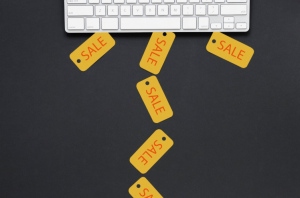Is your business ready for the 2025 payment landscape?
Seamless and secure transactions are the backbone of any retail business today. This guide breaks down retail payment processing, highlighting the must-have information like mobile and contactless solutions, key security measures, and emerging technologies like AI and cryptocurrencies. We’ll simplify the complex roles of retail payment processing systems, processors, and merchant accounts. Business owners will gain actionable insights to enhance customer experience and protect data. You should get prepared for the future of retail transactions today!

Save 80% of delivery management time
We handle everything:
- Dedicated operations manager
- Real-time tracking dashboard
- Automated customer notifications
- Urgent issue resolution
How Retail Payment Processing Works Today
-
Payment processors connect customers to businesses, managing the transaction flow.
-
Key steps: authorization, settlement, and funding.
-
The essential difference is: that payment processors handle data; merchant accounts hold funds.
Role of Payment Processors
Payment processors are the intermediaries between customers and businesses. They ensure transactions go through, approvals happen, and funds end up in the right place. For any business wanting to accept credit, or debit cards, or online payments, a processor is essential. Payment processors like PayPal or Stripe offer the tools to handle transactions, providing security and efficiency. Behind the scenes, they work with banks, payment networks, and several other players. Considering implementing a new payment processor for your business? Don’t make a decision without first checking our thorough POS systems comparison to identify the perfect option for your transaction needs.
Transaction Approval Process
Approval starts with the customer swiping or tapping a credit card amount. The processor sends a request to the issuing bank, asking if funds are available. In seconds, the bank replies. Approved? The transaction proceeds. Declined? The process stops there. Unlock the full potential of a Point of Sale system, from facilitating quick transactions to providing comprehensive payment solutions for your business.
Transaction approval involves various security checks. These include Address Verification Services (AVS) or CVV checks, which help prove the user’s identity. In addition to enhancing payment security, consider how delivery options can affect customer satisfaction. For businesses in the retail sector, reliable and efficient delivery services are essential. Evaluating a trustworthy delivery service in Denver can ensure your customers receive their purchases on time, thereby boosting their overall shopping experience.
Key Components of Payment Processing
Authorization
Authorization confirms that a customer has enough funds or can accept credit card payments. It’s the first step once a payment method is entered. An authorization hold is placed on the account, earmarking the funds. Discover the pivotal role of Point of Sale systems in simplifying the authorization process, ensuring smooth transactions and fiscal security for every sale.
Successful authorization doesn’t guarantee payment, but it’s a necessary checkpoint. It signals the process of payments start, telling the merchant that payment is likely.
Settlement
Settlement refers to moving funds from the issuing bank to the merchant’s bank account. This moves the transaction forward after authorization. It can take a few hours to a few days.
For small businesses, knowing settlement timelines is crucial for cash flow management.
Funding
Funding is the final step when money finally ends up in the merchant’s account. After successful settlement, funds become available. Timeframes and processing fees depend on contracts with processors or banks.
Difference Between a Payment Processor and a Merchant Account
Understanding Payment Processors
Processors are the behind-the-scenes players moving transaction data. Without them, handling electronic payments would be nearly impossible. They provide the infrastructure needed to approve transactions and transfer data.
Insights on Merchant Accounts
Merchant accounts are specialized bank accounts that store money from these electronic transactions. They hold funds in a pending status until settlement is completed. Businesses need these accounts to accept payments.
Integrating Mobile Payment Solutions
-
Mobile payments are fast and convenient.
-
Customers prefer using mobile wallets.
-
Options include Apple Pay, Google Wallet, and Samsung Pay.
Benefits of Mobile Payments
Mobile payments offer many advantages. They’re quick and easy for both customers and businesses. This kind of transaction doesn’t require customers to carry physical cards. It speeds up the checkout process, which can boost sales and customer satisfaction. This lets customers pay while they shop, and makes purchases less stressful during busy times. Enhance the shopping experience and reduce wait times by implementing a portable point-of-sale system, exploring the key benefits of handheld POS devices for your business.
More people want to pay with their phones. Mobile payments can help businesses stay competitive. They meet the growing expectations of their customers. As mobile payment options like Apple Pay, Google Wallet, and Samsung Pay become more common, offering these options becomes crucial for attracting modern consumers.
Business owners can also benefit in other ways. Mobile payments can lead to lower transaction fees compared to traditional credit card payments. With more who accept mobile payments and move online, there are fewer risks associated with handling cash. This contributes to better security and efficiency in daily operations.
Implementing Mobile Payment Systems
Bringing mobile payment systems into your business involves a few steps. First, you need a compatible payment gateway that works with mobile payment services. These gateways act as bridges that process transactions securely. Picking the right one ensures a seamless transaction experience for your customers.
Next, you should ensure your mobile app, if you have one, integrates well with these systems. A smooth mobile app experience with integrated payment options can lead to customer retention. A well-designed app can enhance user experience, encouraging loyal customers to return.
Training your staff is essential. Staff should be familiar with how these payment systems work. An informed team can lead to smoother transactions and happier customers. Employees need to know how to troubleshoot common issues and guide customers who are new to mobile payments. It’s the key to providing a seamless customer experience. This step can’t be skipped. Proper training ensures that transactions go smoothly even during high-traffic periods.
By addressing these areas, businesses can incorporate mobile payment features and solutions effectively. This ensures quicker transactions, improved customer satisfaction, and decreased reliance on traditional cash handling, while also preparing your business for the shift towards more contactless and mobile-based payment strategies.
Embracing Contactless Payment Systems
Why Contactless is Popular
Contactless payments are fast. They process transactions in seconds. This speed reduces waiting time for customers. No more dealing with long queues. This is important in busy retail environments. Discover how seamless transactions are the way forward and why incorporating contactless payment methods can transform your customer experience.
For businesses looking to enhance their delivery services, combining your payment options with an efficient logistics solution can be game-changing. Consider utilizing a reliable courier service in Los Angeles to ensure that your products reach customers swiftly and conveniently, matching the speed of your digital payment systems.
Another reason is safety. With contactless, there’s minimal physical contact. Customers and staff can avoid touching cash or pin pads. This is crucial to avoid spreading germs. Customers feel more at ease using contactless.
These systems use NFC (Near Field Communication) technology. This is in many credit cards and smartphones. NFC allows data to transfer over short distances when devices are near each other. Many people already have the needed tech in their pockets or wallets. There’s no need for additional hardware.
Setting Up Contactless Payments
Switching to contactless payments is straightforward. Here’s how you can do it.
Confirm Your Point-of-Sale Systems Support NFC
-
Check Your Current Equipment: You can look at your point-of-sale (POS) terminals. Do they have NFC capability? Most new devices do, but older models might not. You can look for the NFC symbol on the device.
-
Consult Your Provider: It is better to reach out to your existing payment provider and ask if they support contactless payments. If your equipment is outdated, they might offer upgrades.
-
Test Compatibility: You should do a trial run and ensure that the system processes a contactless transaction without hiccups. You can fix any issues before going live.
Update Software to Accept Contactless Transactions
-
Install Updates: You can check for software updates. Payment system providers release updates to ensure security and new features. You should make sure your software is current.
-
Follow Installation Steps: You can install updates exactly as instructed. You shouldn’t skip steps. This might include restarting your POS system.
-
Security Patches: Some updates include security patches. These protect against vulnerabilities. You should never ignore these updates.
-
Confirmation: You can verify that the terminal complies with industry standards. This ensures it is certified for contactless payments.
Educate Customers on Using Contactless Options
-
Create Clear Signage: You can place signs near checkout points. These should indicate contactless payments are available. It is better to use simple language and clear symbols.
-
Train Staff: You can educate your staff about how contactless payments work. They should help customers who are new to the system.
-
Promotional Material: It is better to consider flyers or emails. Outline the benefits of contactless options. You can mention speed and safety. You should encourage customers to switch to contactless.
-
Customer Support: You can set up a support line or helpdesk and assist customers with questions or issues related to contactless transactions.
Each step builds towards offering a seamless contactless payment and online store experience. Once set up, businesses can offer faster, safer, and more convenient transactions—all vital for staying competitive in the current retail market.
Keeping Payment Data Secure
-
PCI compliance prevents fines and litigation.
-
Encryption and tokenization shield data.
-
Multi-factor authentication adds a security layer.
Essential Security Protocols
PCI Compliance
PCI DSS, or Payment Card Industry Data Security Standard, plays a key role in securing payment transactions. It sets detailed requirements every business must follow when handling cardholder data. Without PCI DSS adherence, businesses risk serious issues. Non-compliance can lead to fines, legal troubles, and damaged reputation. The PCI DSS isn’t just about meeting set rules; it’s about creating a culture of security. This framework prompts regular updates and establishes robust security measures.
Encryption
Encryption is crucial in making sure that payment data remains safe. By converting data into a code during transit, encryption shields it from unauthorized access. The encryption process ensures that even if data is intercepted, it’s unreadable. According to experts, “encrypt data at rest and in transit,” making it a basic necessity for any payment system. Encrypted data becomes a collection of random numbers and letters to anyone without the correct key. Moreover, with advances like end-to-end encryption, businesses ensure that data remains protected throughout the transaction journey.
Tokenization
Tokenization serves as another essential tool in securing payment data. It swaps out sensitive data with non-sensitive equivalents, known as tokens. These tokens have no value on their own and are useless if intercepted. Among the benefits is that systems processing transactions deal with tokens rather than vulnerable data. This drastically reduces exposure to potential breaches. While encryption and tokenization are related, tokenization specifically focuses on replacing sensitive data and minimizing risk.
Steps to Enhance Payment Security
Regular Updates
Keeping systems updated is a fundamental step in payment data security. “Regularly scan your APIs for vulnerabilities and patch them promptly.” This proactive approach helps protect systems against evolving threats. Updated systems can fight against new kinds of attacks that exploit older vulnerabilities. Ignoring updates creates gaps, leaving systems exposed to attackers.
Multi-Factor Authentication
Multi-factor authentication (MFA) adds an extra layer of security, making sure only authorized access occurs. Alongside passwords, it requires additional verification methods, like codes sent to mobile devices or biometric checks. Experts agree, “Implement strong authentication and authorization protocols,” reinforcing the need for MFA in payment systems. While MFA might need initial setup efforts and user training, the security benefits outweigh the challenges.
Employee Education
Educating employees on security practices strengthens a business’s overall security stance. Staff should know how to identify phishing attempts, use secure passwords, and understand role-based access controls. An informed team can act as a frontline defense against potential threats. While not directly quoted here, employee awareness continuously emerges as crucial in preventing breaches.
Implement Role-Based Access Control
Role-Based Access Control (RBAC) limits data access based on user roles. This method assures that only those who need data access can obtain it. Assigning permissions tied directly to job roles restricts unnecessary exposure of sensitive data. RBAC is a vital tool for protecting payment systems against misuse by unauthorized employees, and RBAC authorization can help reinforce these safeguards by clearly defining user roles and permissions. Setting up RBAC may require detailed planning, but it prevents internal and external exploitations.
Conduct Regular Security Audits
Conducting security audits illuminates gaps and vulnerabilities a business might miss during daily operations. These audits assess the system’s overall capacity to withstand attacks, ensuring the implemented measures remain effective as threats evolve. Audits can identify weak spots before criminals exploit them.
With these measures, businesses create a secure payment environment, safeguarding customer data and maintaining trust. Understanding and implementing these strategies prepares businesses for the ever-changing challenges of payment security.
Trends in Emerging Payment Technologies
Impact of AI and Automation
Artificial intelligence and automation have significantly changed payment technologies over the last year. One key application is in fraud detection. AI systems now analyze patterns in transaction data to flag unusual activities, making it much harder for fraudsters to succeed. Around March 2024, many companies reported a decline in fraudulent activities. By mid-year, AI tools were cited by major businesses as saving millions of dollars annually.
AI also personalizes shopping experiences by analyzing customer behavior. This means retailers can offer more tailored promotions. Customer feedback has shown increased satisfaction as businesses adapt to changing preferences more quickly. Automated systems have begun to revolutionize back-end processes. Businesses can now automate payment approvals and transaction updates, freeing up human resources for more strategic tasks.
Automating Payment Approvals and Fraud Detection
In January 2023, a leading retailer integrated an AI-based transaction approval system. This reduced manual operations by 30%. As businesses increasingly adopt such systems, the next few months will likely see more in-depth integration of AI. The second half of 2023 saw many businesses making AI investments a priority.
Personalizing Customer Experiences
By April, retailers began to deploy AI for customized promotions and product suggestions. This has been key to boosting sales and providing a better in-store experience. Feedback loops from these systems allow quick adjustments to marketing strategies. By September, larger retail chains noted a 15% increase in customer engagement thanks to AI-driven personalization.
Streamlining Back-End Processes
Automating these processes became mainstream with many retailers globally in the past six months. In June and July, reports of shortened transaction times and improved inventory management were reported. Because automated systems handle repetitive tasks, like approvals and updates, staffing costs went down. By September, many companies reported more efficient financial reporting.
Adoption of Cryptocurrencies
Cryptocurrency is making headway in retail sectors. Bitcoin, Ether, and others saw increased adoption for payments. Since early 2023, a rise in crypto use in retail payment systems has been noticed. A breakthrough occurred around June, as big names started accepting Bitcoin, allowing a wider range of transaction options.
Growing Acceptance in Retail for Digital Currencies
Physical stores are beginning to see the value in accepting payments in digital currencies. Over the last year, there was a 40% rise in retailers open to crypto payments according to recent surveys. This was especially notable in stores where younger demographics shop. Businesses also see the advantage of quicker settlement times with cryptocurrencies, particularly in crypto-friendly countries where regulations support digital asset transactions.
Ensure Your System Can Accommodate Cryptocurrency Transactions
For these transactions, retailers have updated systems to manage compliance, including understanding crypto taxes to ensure rigorous adherence to guidelines. Around August, many firms optimized their systems for crypto. There is a push to integrate crypto payment options without risking security vulnerabilities.
Evaluate Market Trends to Decide on Adoption
About mid-year, companies began rigorous evaluations of crypto market trends. By September, many developed departments to analyze cryptocurrencies’ impacts on sales and customer engagement. A few noted that the fluctuation in value affected pricing strategies, requiring careful planning.
The past year has seen notable advancements in AI and the growing acceptance of cryptocurrencies in payment systems. With these trends, staying current and flexible in payment processing services can offer clear advantages. Utilizing tools like the crypto app for beginners can help individuals and businesses alike navigate this evolving landscape more effectively. As these technologies mature, businesses that invest wisely stand to gain significant benefits, both financially and operationally.
Predictions for 2025 in Retail Payment Processing
-
Subscription models offer steady revenue.
-
Biometrics improve transaction security.
-
Multi-channel payments ensure consistent shopping experiences.
Growth of Payment Subscriptions
Payment subscriptions have gained traction in 2024 as a strategic tool for creating steady revenue. Businesses have increasingly used these models not just for product-based services but also for loyalty programs. Instead of single transactions, companies are encouraging customers to opt for monthly or yearly subscription plans.
Monthly Subscription Adoption
In early 2024, subscription services became more versatile. This approach allows businesses to secure regular income and build stronger relationships with customers. By mid-2024, many retailers started bundling products with rewards programs. This combination gives consumers more reason to stay subscribed. The consistent income stream assures businesses of more predictable financial planning.
Revenue Stability
Subscription models are not only about stability. They also offer businesses insights into customer preferences and buying habits through regular engagement. Over the past year, there’s been a noticeable shift towards using data from subscription habits to tailor offerings, enhancing customer loyalty and satisfaction. This strategy should continue in 2025, with more companies exploring subscription avenues to solidify their market position.
Expansion of Biometric Accept Payment Options
Biometric payment systems have become more common in 2024, driven by the need for enhanced security and faster transactions. Fingerprint and facial recognition technologies have seen considerable investment and adoption. Learn about the must-have features of retail point of sale systems in 2025 to provide secure and speedy service to your customers.
Security and Speed
Biometric systems improved security by adding a layer beyond traditional passwords or PINs. In 2023, biometric payments started to be integrated with existing payment systems, allowing faster checkouts. As more retailers adopted these technologies, customers familiarized themselves with the practice, experiencing not only faster but also more secure transactions. Seeking the ideal POS system for your small business that incorporates biometric technology? Our detailed guide can assist you in finding the top choice to enhance security and checkout speed.
Biometrics in Daily Use
Possibly reaching their peak in early 2025, biometric tools are expected to make transactions quicker and fraud less likely. Adoption will speed up as tech evolves, becoming more reliable and user-friendly. Businesses investing in biometric integration see reduced fraud and greater customer satisfaction. Discover how restaurant point of sale (POS) systems incorporating biometric technology can revolutionize the dining experience by enhancing security and streamlining operations.
Importance of Seamless Multi-Channel Payments
With retail landscapes shifting, the ability to offer seamless multi-channel payment experiences has become a major focus. More businesses are looking for retail payment solutions that unite offline and online shopping into a single ecosystem.
Consistent Customer Experience
In 2024, consistency emerged as key. Retailers prioritized offering consistent experiences in both store and online settings. This consistency requires systems that can synchronize customer data and transaction histories across devices and platforms. The aim is to ensure customers don’t face disparity regardless of where they shop. One effective way to enhance your logistics for improved customer satisfaction is through reliable delivery services. Learn more about the benefits of partnering with a trusted courier service in San Antonio to streamline your operations and ensure timely deliveries.
Versatile Payment Options
Alongside consistency, customers now expect versatility in their retail payment methods and options. The latter half of 2024 saw increased demand for systems allowing various payment methods, whether that’s credit cards, digital wallets, or instant payments. Moving forward, businesses need to cater to these expectations to remain competitive.
Final Thoughts on Retail Payment Processing in 2025
You now have a clearer picture of today’s retail payment and credit card processing and how important it is for your business. From mobile and contactless payments to keeping customer data secure, staying ahead means embracing what’s new. Now, here’s where to go from here:
-
It would help if you were sure your payment systems are up-to-date and meet customer needs.
-
You can train your team to handle mobile and contactless transactions smoothly.
-
You can keep yourself informed about upcoming tech, like AI, automation, and cryptocurrencies.
It is better to consider how these payment methods align with your business goals. Are you ready to adapt to the changing needs of your customers? Applying these insights will set you up for success in the evolving retail landscape.




